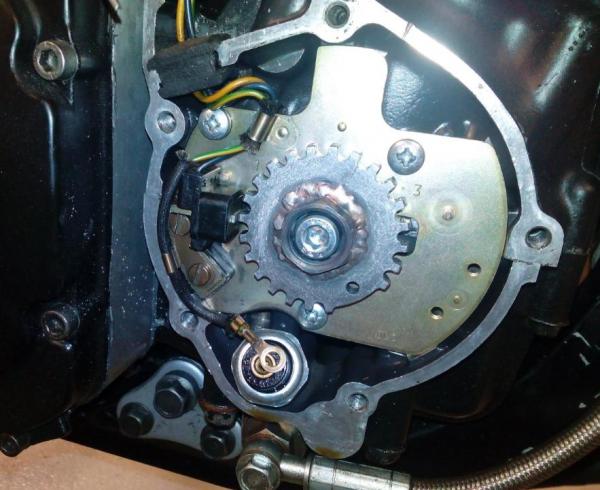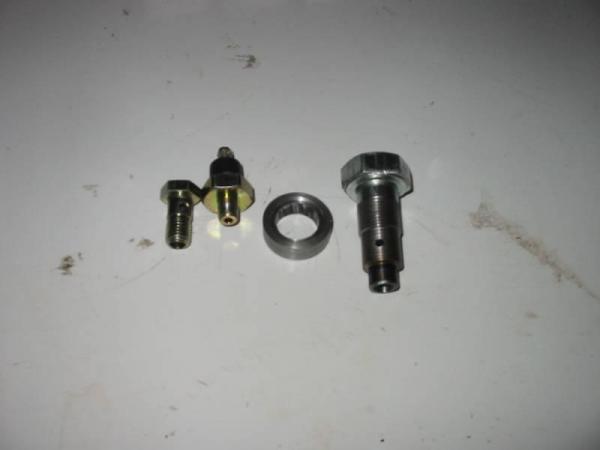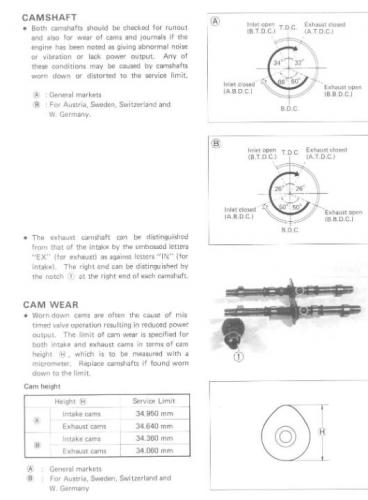

Arttu
-
Posts
908 -
Joined
-
Last visited
Content Type
Profiles
Forums
Events
Posts posted by Arttu
-
-
Yep, 17 or 18 on front is good choice to get proper sprocket diameter. And with 17T front 48T on rear results the stock ratio. For chain length you can measure your current distance between the sprocket centers and then use the Gearing Commander to see how many links you need to achieve that. I guess 112-114 should be close.
I don't remember part numbers any more but finding suitable 530 sprockets should be pretty easy. If I recall correctly oil cooler sprockets work on front. Can't recall for sure since it has been a while since I have used non-offset ones
-
 1
1
-
-
17 hours ago, CockneyRick said:
Are we sure on this?
Options out there are M14x1.25 pitch, which seems to be a popular thing for Suzuki?
Yes, I just double checked, definitely M14x1.5. (EFE engine)
M14x1.25 is indeed used on several other places like main oil gallery plug and rocker shaft plugs but the cooler take-offs are an exception.
-
 2
2
-
-
Good question, I was wondering the same just yesterday. Originally they are different indeed. But now the parts fisches say that the left one has been superceded by the right one. And when test fitting the old ones to the head I can't see much difference between them if I just flip around the right side one. So I assume it's fine to use the same part number for all.
-
I have that kind small manifold for MAP and regulator, connection to each throttle is through small orifices. Works well but on the other hand just connecting all the take-offs together with typical vacuum hoses and T-joints seems to give almost as good result. In contrast using just one throttle results quite badly jumping MAP readings.
Typically take-offs on the throttle bodies are so small that air flow through them can't cause any noticeable effect for cylinder balance.
-
They have letters A, B, C... on them and matching letters can be found on the head.
-
Basically you can use LiFePo batteries with the same regulator than normal lead acid battery. Maximum voltage is pretty much the same for both. However, LiFePo is less tolerant for both under and over voltages. Anything below 13V won't charge it at all and over voltage will destroy it faster than a lead acid battery.
And one additional note for anyone reading this: Make sure you don't mix LiFePo batteries with LiPo/LiIon batteries. Latter ones have different voltage range and they can be dangerous if charged incorrectly!
-
1 hour ago, Swiss Toni said:
Yeah, but if he goes directly to either of the ones I noted, he’ll be ok. They’re both good products!

Sure. But he was asking for the best.

-
 1
1
-
-
Shindengen SH-775, used on some Polaris quads etc. It's series type so it doesn't load the generator when there isn't high load from the bike. Just be aware that there is loads of fakes sold on Eblag etc.
-
 1
1
-
-
Yep, if I recall correctly my '83 1100E had paper base gasket. And that was pretty much the latest of the 1074cc engines.
-
I don't know how it works with Ignitech but with MS1 the reference teeth had to be before your highest ignition timing. Meaning if you want to use maximum 40° ignition advance then the reference tooth must be at 45° BTDC or earlier. But preferably not too much earlier since that would increase timing error.
-
What? I guess that's some ECU specific stuff?
With most of the ECUs that I have played with you just enter angle of #1 tooth and angles between the cylinders. Then the ECU will handle the rest to get desired ignition timing. Old Megasquirt 1 was an exception where you had to fill in reference trigger tooth numbers for each cylinder within certain window from ignition event.
-
Tooth #1 is usually the first one after missing one(s). Most of the ECUs are quite flexible for location of the #1 tooth / missing tooth. But for reliable decoding during cranking it would be best to place it at point where the crank speed is highest during cranking. Apparently this is around 100° BTDC on inline 4 engines.
Reading point of a tooth should be in the middle of the tooth. When using VR type sensors. This is the point where polarity of signal reverts and crosses 0V level. With hall type sensors the point would be either edge of the tooth. For reference see: http://www.useasydocs.com/theory/pickups.htm
Just in case if you get fed up making the trigger wheel, I can deliver a 24-2 wheel for oil cooled engines. Should fit on some water boilers too.
-
 2
2
-
-
I think "because you can" is a pretty good answer for "Why?" question. "Learning something new" is another good one. If we are talking about relatively stock engine benefits of EFI won't be huge compared to well working carbs so it's hard to justify the effort just by them. With boosted or otherwise heavily modified engine the benefits can be more significant. But as my personal opinion you could spend your time and money in much worse ways than converting a stock engine to EFI. I just recommend to take it as a learning project instead of simple fit and forget update.
Naturally there will be several somewhat tricky problems to solve but none of them should be too complicated and definitely nothing that hasn't been done earlier. Mentioned TB fitment is one of the challenges but it isn't any more complicated than other ones and should be doable with some effort.
There is plenty of info on the forum about the topic and I would recommend doing some searching and reading first. For starters here are a couple of threads that are worth of checking.
Feel free to ask if you have any specific questions about basically anything EFI related.
-
@ReinhoudYou got it pretty much correct:
1: Correct.
2: Yes, spacer. Only needed since I couldn't make threads up to head of the bolt.
3/6: Oil pressure switch for oil light. 0.3 bar, from some random car.
4: Banjo bolt for turbo feed line.
5: Turbo oil feed line.
You are right, it's somewhat tricky to be sure that all parts of the engine get enough oil after messing up with the system. But it helps to figure it out if you keep in mind that the oil pump is positive displacement type meaning the flow isn't significantly affected by pressure. So if you add restriction after the pump the pressure before restriction goes up but oil flow after the restrictor remains about the same. So with this modification oil flow to the engine is reduced only by amount that goes through the turbo, which should be relatively small with most of the turbos. In my case I installed also 750 pump gears at the same time with the turbo system. To verify the result I measured the pressure from the crank oil gallery before and after modification and the result was the same or even more after the mods. So the engine was still getting at least as much oil than as stock.
However, this mod is far from ideal. The pressure for the turbo varies a lot depending on rpm and oil viscosity. So as you said, with cold oil the pressure is much higher and it's a good idea to keep revs low until the oil is warmed up. When the oil is hot the pressure at idle drops pretty low, below 0.3 bar in my case. But at rpm where the turbo spools up there was always pretty good pressure so the turbo was happy.
Scavencing was just gravity drain to the sump plug in the first revision. Later on I made a deeper oil pan with dedicated connection for the oil return.
-
9 hours ago, Reinhoud said:
You never get pressure with a GS engine!! Only when the engine is cold, I experimented with that.
I've got a GS1000, with a wider pump, and I had an even wider home made pump and with 750 gear ratio, restriction in the oil gallery to the gearbox, and still no pressure, it did raise the pressure when cold, but that dropped when the engine warmed up.
Beep, wrong!
 With the mod pictured above I had about 3-4 bar pressure for the turbo, warmed up. I run a plain bearing turbo with that for about 20 000km without issues.
With the mod pictured above I had about 3-4 bar pressure for the turbo, warmed up. I run a plain bearing turbo with that for about 20 000km without issues.
-
The big "bolt" in lower picture is the actual trick. It goes in place of the oil pressure switch, the tip goes into oil channel coming from the filter so it captures all the oil flow. Oil to the engine is bled through a small hole on side of the bolt. The turbo gets unrestricted oil flow from top of the bolt. Pressure for the turbo can be adjusted by size of the bleed hole. On top of everything there is also a pressure switch from some car to replace the original pressure switch.
-
-
The pump gears are the same for plain and roller bearing 750s. So unfortunately no help for you that way. However, most likely it's possible to add a restrictor on the oil channel somewhere between the filter and rest of the engine and take oil to the turbo from front side of the restrictor. This way you should be able to get high enough pressure even for a plain bearing turbo. I'm not very familiar with the 750 engines so can't tell exactly how this should be done but I guess it's doable.
-
 1
1
-
-
Actually I haven't used a 1150 transmission with 1100 cases, only with 1150 cases. But based on pretty good understanding of lubrication system of these engines I would say it shouldn't make any difference if a 1150 tranny is placed in 1150 or 1100 cases.
-
If I understood correctly that plug with hole basically bleeds oil inside the clutch?
I have played with both 1100 and 1150 transmissions but haven't ever compared the parts against each other in details. However, the lubrication circuit is basically the same on both engines so 1150 transmission shafts in 1100 engines shouldn't do any harm. I guess this hole is added to get a bit more oil in the clutch hoping to improve its behavior. It seems that Suzuki has done quite many this kind fine adjustments for clutch oil control over the years. -
-
According the parts fisches the pumps are the same for both. So I assume yes

-
2 hours ago, Gixer1460 said:
But the Katana rods are stronger - racers usually will strip a crank to fit them - 493 - is the number. If you go that far then swaping pistons for smaller pins is a given anyway!
True. But maybe worth of adding that EFE/1150 rods are still pretty strong too. So this shouldn't be any real concern except the on the most radical builds.
-
Usually not. But I can hear it if I listen carefully and play with the throttle just right way.
Once I test rode a twin turbo Yam Vmax that had Tial BOVs hanging on sides of the "tank" just in front of your knees. That made a pretty nice soundtrack with clear effects when you let off the throttle





Vacuum take offs...
in Forced Induction
Posted
Ideally you want the fuel pressure react to vacuum too. That way the pressure over the injectors stays constant and you get always the same amount of fuel with certain injection duration. Without vacuum to the regulator the effective pressure will get higher when there is vacuum at the intake and that results worse resolution for tuning.
If the take-offs are done properly the pressure shouldn't jump too much.